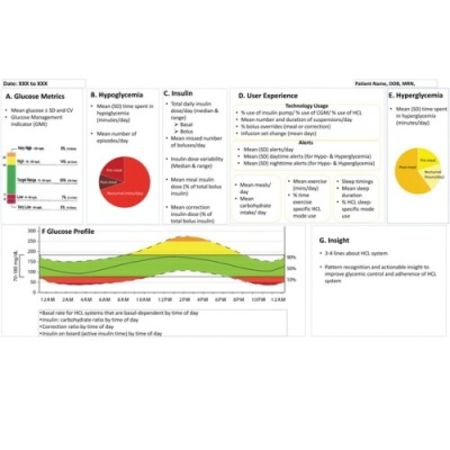Hybrid closed-loop (HCL) systems are designed to improve glycaemic control in diabetes patients. HCL settings need to be optimised to achieve the desired glycaemic outcomes, but doing so means patients must be able to interpret glucose and insulin metrics. However, interpreting HCL data is not easy since HCL systems currently do not have a standardised method of reporting.
You might also like:Advancing the Understanding and Treatment of Type 2 Diabetes
New research from the Barbara Davis Center for Diabetes at University of Colorado has proposed a one-page HCL data reporting called ‘artificial pancreas (AP) Dashboard’ – with detailed information and visualisation for glucose, insulin and HCL-specific metrics. This standardised report can be likened to an electrocardiogram that contains vital information for quick review by the providers and patients, helping them to make informed decisions regarding diabetes care.
The AP Dashboard, as proposed by the researchers, will include these seven components:
Glucose metrics: Composed of four variables (1) mean glucose, (2) standard deviation (SD) and/or coefficient of variation (CV), (3) glucose management indicator (GMI), and (4) a visual graph displaying the recommended CGM metrics, such as time-in-range (TIR) of 70–180 mg/dL, time-above-range (TAR) of >180 and >250 mg/dL, and time-below-range (TBR) of <70 mg/dL (level 1) and <54 mg/dL (level 2).
Hypoglycaemia: Includes level 1 (CGM glucose <70 mg/dL) and level 2 hypoglycaemia (CGM glucose <54 mg/dL).
Insulin: With data on (1) Total daily insulin dose (mean ± SD) and percentage of basal and bolus; (2) Missed bolus insulin (average per day); (3) Insulin dose variability; (4) Mealtime insulin and correction insulin as a percentage of total daily bolus insulin dose.
User experience: Five features are included – use of technologies (covering HCL metrics such as percentage of insulin pump and CGM use); alarms/alerts (each alert needs to be identified as resulting from hypoglycaemia or hyperglycaemia); carbohydrates (mean ± SD g/day); exercise-related information (at least 150 minutes of moderate intensity exercise a week is recommended, along with 2-3 days of resistance exercise to reduce cardiovascular risk); and sleep-related information.
Hyperglycaemia: Information on total time spent in hyperglycaemia (daytime vs. night-time and daytime further divided by premeal and three-hour postmeal).
Glucose profile: Provides a visual glucose display as a model day (aka: a standard day or average day) where all collected data (minimum of past two weeks) plotted by time, as if they occurred for 24 hours starting and ending at midnight. Plus, modifiable HCL system factors such as basal rate, carbohydrate ratio, correction factor, and insulin on board underneath the glucose visual modal-day curve.
Insight: First paragraph of the insight section includes a summary of the HCL system, focussing on modifiable settings such as changing carbohydrate-to-insulin ratio to minimise hypoglycaemia and improve diabetes control. Also, providing insight to improve the user experience may be helpful.
"A single-page AP Dashboard report is likely to be adopted more widely and reduce the burden of diabetes," the researchers explain. "We realise that this is only a starting point and fully understand that this can and will be improved with others' input." They add that future research should include assessment of the utility of the AP Dashboard by physicians and patients to improve glycaemic outcomes.
The authors also highlight the need for expert consensus in building HCL data standardisation, such that gathering the views and opinions of different providers including adult and paediatric endocrinologists, primary care practitioners (internal medicine and family medicine), emergency physicians, and certified diabetes device trainers and educators.
Image credit: Shah and Garg 2020























